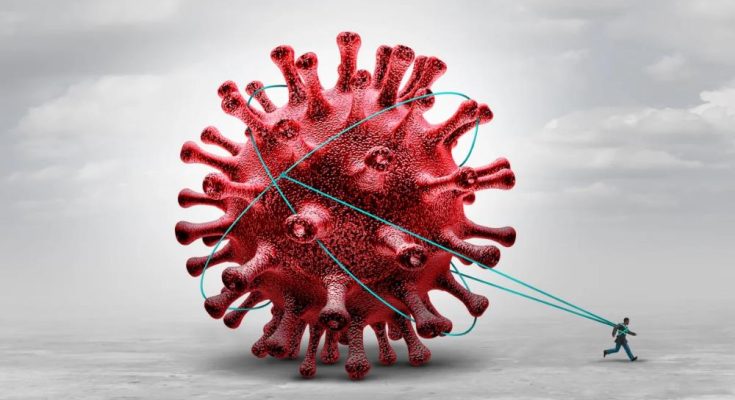In addition to age, the chances of a woman having lingering or new symptoms in the months and years after having COVID-19 were also dependent on pregnancy and menopausal status, the study found.
Recognizing differences in long COVID risk as they relate to sex assigned at birth can help providers diagnose and treat patients with long COVID more effectively, says corresponding author Dimpy Shah, MD, PhD, assistant professor of population health sciences at the University of Texas Health Science Center in San Antonio.
About 8 Percent of Americans Report Having Had Long COVID
Midlife Women Have a 45 Percent Higher Risk of Long COVID
Researchers used data from over 12,000 adults who enrolled from October 2021 through July 2024 and who had a qualifying study visit six months or more after having COVID-19. In-person assessments and lab work took place at least once a year, and participants filled out a symptom questionnaire every three months.
Even after the investigators considered factors like race, ethnicity, COVID variant, severity of COVID infection, and other nonmedical social factors that affect health such as education and income, the data revealed that the women in the study were 31 percent more likely to have developed long COVID compared with the men.
Other key findings included:
- In people ages 40 to 54 years, the risk difference between sexes was even higher: 42 percent higher in menopausal participants and 45 percent higher in nonmenopausal female participants, compared with male participants.
- In people 55 and older, women were 34 percent more likely to get long COVID.
The clinical and public health implications of these findings are substantial, says Dr. Shah.
“It is important to disentangle the role of aging, hormones, inflammatory response, and comorbidities underlying these differential long COVID risk profiles and to identify which groups may benefit from specific treatments. Understanding the mechanisms of sex differences can provide preventive and management strategies for not only long COVID but also other post viral illnesses,” she says.
Men and Women Have Different Long COVID Symptoms
“Symptoms of long COVID can vary among individuals, and while there are no definitive symptoms, there are some that are more common than others such as fatigue, postexertional malaise, and cognitive changes,” says Linda Geng, MD, co-director of the Stanford Post-Acute COVID-19 Syndrome Clinic in California, who was not involved in the study.
Generally speaking, “Men and women suffer from a distinct set of symptoms of long COVID,” adds Akiko Iwasaki, PhD, director of the Center for Infection and Immunity at the Yale School of Medicine in New Haven, Connecticut, who was not involved in the research. “For example, this study found that symptoms such as gastrointestinal issues, hair loss, and dry eyes were experienced more frequently by women, whereas men reported more frequent symptoms including changes in sexual desire or capacity and depression.”
Sex Differences in Long COVID Symptoms May Be Driven By Hormones
“We believe that sex differences in long COVID risk may be driven sex hormones and further research should be aimed at examining the levels of hormones at various stages of life in relation to risk for long COVID, the role of contraceptives, and hormonal therapies,” says Shah.
“Certain comorbidities such as autoimmune disorders as well as post-viral syndromes are also driven by sex differences, which may increase the risk for long COVID,” she says.
Iwasaki agrees that hormones factor into the differences, and her research looked into the “why.”
“We found that one of the key factors controlling the sex difference in long COVID susceptibility and severity is the difference in sex hormones. We found that testosterone is significantly decreased in women with long COVID, and that reduction in testosterone levels was the top hormone predictor of long COVID,” she says.
Testosterone’s influence on immune function could potentially explain its association with reduced symptom severity, says Iwasaki.
The Understanding of Long COVID Has ‘Come a Long Way’
“We have come a long way in our understanding of long COVID but more needs to be uncovered,” says Shah.
Patient advocacy and continued research helped overcome initial skepticism about long COVID as a legitimate diagnosis, as people often labeled it as anxiety or chalked up the symptoms to preexisting conditions, she says.
“Long COVID is now widely accepted as a real and debilitating condition, though our understanding of its mechanisms and effective treatments remains incomplete,” says Shah.
There is also more clarity on the vast array of symptoms and manifestations that people with long COVID experience, says Dr. Geng.
“It’s now more appropriate to reframe long COVID as an umbrella term that encompasses many different subtypes rather than just one entity,” she says.
She says that subtypes of long COVID can overlap with known syndromes such as chronic fatigue syndrome (also called myalgic encephalomyelitis) and postural orthostatic tachycardia syndrome (POTS).
POTS is a disorder of the autonomic nervous system (fight-or-flight) in which a person has a rapid increase in heart rate when standing up from a sitting or lying position, which can cause dizziness, lightheadedness, or fainting due to a drop in blood pressure.[6]
Researchers hope that new insights into the “who,” “what,” and “why” of long COVID might help simplify diagnosis, pave the way to large new clinical trials, and identify new treatments.
“At this time, we have no cure for long COVID, and that is an urgent need,” Geng says.
Editorial Sources and Fact-Checking Everyday Health follows strict sourcing guidelines to ensure the accuracy of its content, outlined in our editorial policy. We use only trustworthy sources, including peer-reviewed studies, board-certified medical experts, patients with lived experience, and information from top institutions. Sources Shah DP et al. Sex Differences in Long COVID. JAMA Network Open. January 22, 2025. Vahratian A et al. Prevalence of Post-COVID-19 Conditions and Activity-Limiting Post-COVID-19 Condition Among Adults. JAMA Network Open. December 13, 2024. Dou DR et al. Xist Ribonucleoproteins Promote Female Sex-Biased Autoimmunity. Cell. February 1, 2024. Dessi ZG et al. Mortality-Related Risk Factors of COVID-19: A Systematic Review and Meta-Analysis of 42 Studies and 423,117 Patients. BMC Infectious Diseases. August 21, 2021. Silva J et al. Sex Difference in Symptomatology and Immune Profiles of Long COVID. medRxiv. March 4, 2024. Postural Orthostatic Tachycardia Syndrome (POTS). Cleveland Clinic. September 9, 2022.
Source: EverdayHealth



